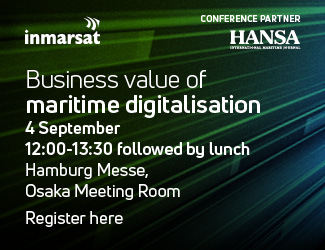Thorny Ireland-UK border issues have moved to the fore in Brexit negotiations
in recent weeks, highlighting the need for more direct short-sea shipping
capacity between the Republic of Ireland and the rest of the EU
Shipping and the movement of goods by sea are vital to the economy of island nation Ireland, accounting for some[ds_preview] 92% of all exports/imports by volume, according to figures from the Irish Marine Development Office (IMDO). But much of this trade takes the form of truck-carried RoRo traffic, with some 60% of this trade between Ireland and continental Europe using the so-called ‘land-bridge’ route via the UK. And there are fears that this route will cost more and involve greater delays post-Brexit because it will need to cross two sets of EU/UK borders.
Cobelfret subsidiary CLdN is already anticipating more direct trade between Ireland and continental Europe by introducing Irish calls by the world’s largest short-sea freight RoRo ferry, »Celine« (see page 56). With its 8,000 lane metre capacity, the 800-metre long ship will be able to carry more than 600 freight units on links between Dublin and Zeebrugge, also calling Esbjerg, Gothenburg and Leixoes. A sistership is due to be added next year, linking Dublin with Rotterdam (and calling UK ports Killingholme and Purfleet en route).
Dublin Port Company chief executive Eamonn O’Reilly says that Brexit uncertainty means the port is already receiving increased demand for direct freight services to Europe, and that he expects to see the introduction of »more new services to Continental Europe during 2018«.
Port of Cork commercial manager Capt. Michael McCarthy has also called for the introduction of more direct shipping links from Ireland to continental Europe, pointing out that »there is a huge case to be made for the likes of Cork to be utilized to import and export straight to and from the continent« rather than using the UK land-bridge. Cork is the main port serving the south of Ireland and handles a full spectrum of cargo types, including Lo-Lo, RoRo, liquid bulk, dry bulk, breakbulk and passenger. It has invested 72m € in improving infrastructure since 2000 and describes itself as »ideally positioned for additional European trading as well as for yet unexploited direct deep-sea shipping services.«
Grimaldi Lines already operates out of Cork, offering RoRo connections to its network of routes covering north Europe, the Mediterranean and West Africa, while Brittany Ferries offers RoPax sailings between Cork and Roscoff.
IMDO is also the designated Shortsea Promotion Centre in Ireland for shortsea shipping in line with EU policy and has been a member of the European Shortsea Network (ESN) since March 2001.
Irish Ferries, part of the ICG group, is Ireland’s main domestic carrier of RoRo freight as well as passenger traffic between Ireland and the UK, operating a fleet of Ro-Pax ‘cruiseferries’ as well as fast ferries, mainly on the Dublin-Holyhead and Rosslare-Pembroke routes. However, it also operates links to Cherbourg and Roscoff in France, and will step these up in summer 2018 with introduction of regular high-season sailings using new RoPax cruiseferry W.B. Yeats.
One company to have capitalized on strong freight traffic between the Republic of Ireland and UK in recent years is Seatruck Ferries, now operating four daily services between Dublin and the Liverpool area. In the month of October 2017 alone it moved just under 21,000 freight units, compared to only 3,000 when it began 10 years ago.
Meanwhile, the UK’s largest short-sea ferry and freight carrier P&O Ferries has said it will »continue to monitor then negotiations between the UK and EU very closely« with a view to providing »a comprehensive ferry and logistics service to and from the continent.«
Should significant extra demand for direct Ireland-Continent sailings arise, the company will look to plug the gap with new services as »we are always looking for opportunities as regards new routes,« said a spokesman.
However, the company feels that fears over future trade disruption may be overblown, and recalls the situation back in 2015 when trade disruption at the Dover-Calais border was quickly resolved at a political level as it was in neither country’s interest.
Stena Line claims to be market leader on Irish Sea services, mainly operating crossings between Belfast, Northern Ireland and the Liverpool area. It is currently building four new fuel efficient RoPax vessels at the AVIC Shipyard in China, scheduled for 2019-20 delivery and destined for use on the company’s Belfast routes.
»During the last few years we have seen a steady growth in freight and passenger volumes and we believe this will continue,« says chief executive Niclas Mårtensson. »Last year was a record year for us when we for the first time carried over 500,000 freight units through Belfast Port.«
Another new development on Irish short-sea trades next year will be the introduction of an »Ireland-max« class of vessels being built by BG Freight Line, a subsidiary of Peel Ports, owner of Port of Liverpool. Four vessels are currently under construction in China, each capable of carrying 1,004TEU, and will be operated on the company’s short-sea hub feeder services linking Ireland, the UK, Belgium and the Netherlands. Headquartered at Rotterdam Short Sea Terminals, BG Freight Line currently runs 23 fully containerized vessels on a fixed sailing schedule to some 29 ports and terminals. One of the company’s main roles is to provide feeder services to the 400m $ new deepsea container terminal at Port of Liverpool (L2) that opened last year, targeting mainline trade from North America and Asai via the Panama Canal.
















